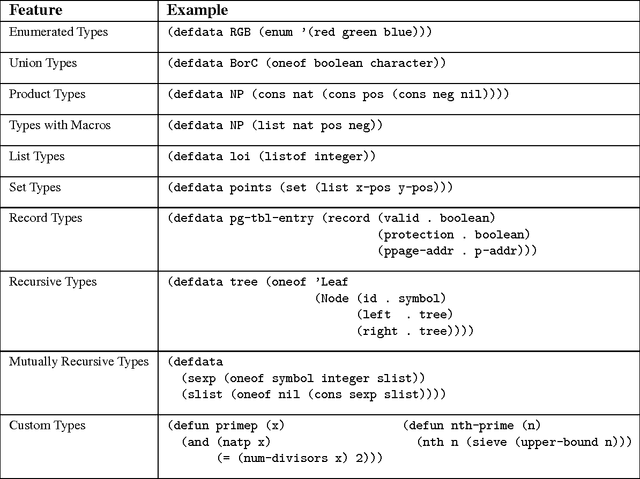Matt Kaufmann
UT Austin, retired
Advances in ACL2 Proof Debugging Tools
Nov 15, 2023Abstract:The experience of an ACL2 user generally includes many failed proof attempts. A key to successful use of the ACL2 prover is the effective use of tools to debug those failures. We focus on changes made after ACL2 Version 8.5: the improved break-rewrite utility and the new utility, with-brr-data.
* In Proceedings ACL2-2023, arXiv:2311.08373
A Versatile, Sound Tool for Simplifying Definitions
May 03, 2017Abstract:We present a tool, simplify-defun, that transforms the definition of a given function into a simplified definition of a new function, providing a proof checked by ACL2 that the old and new functions are equivalent. When appropriate it also generates termination and guard proofs for the new function. We explain how the tool is engineered so that these proofs will succeed. Examples illustrate its utility, in particular for program transformation in synthesis and verification.
* In Proceedings ACL2Workshop 2017, arXiv:1705.00766
Proceedings Thirteenth International Workshop on the ACL2 Theorem Prover and Its Applications
Sep 18, 2015Abstract:This volume contains the proceedings of the Thirteenth International Workshop on the ACL2 Theorem Prover and Its Applications, ACL2 2015, a two-day workshop held in Austin, Texas, USA, on October 1-2, 2015. ACL2 workshops occur at approximately 18-month intervals and provide a major technical forum for researchers to present and discuss improvements and extensions to the theorem prover, comparisons of ACL2 with other systems, and applications of ACL2 in formal verification. ACL2 is a state-of-the-art automated reasoning system that has been successfully applied in academia, government, and industry for specification and verification of computing systems and in teaching computer science courses. In 2005, Boyer, Kaufmann, and Moore were awarded the 2005 ACM Software System Award for their work on ACL2 and the other theorem provers in the Boyer-Moore family.
* Celebrating the 25th anniversary of ACL2
Enhancements to ACL2 in Versions 6.2, 6.3, and 6.4
Jun 06, 2014Abstract:We report on improvements to ACL2 made since the 2013 ACL2 Workshop.
* In Proceedings ACL2 2014, arXiv:1406.1238
Enhancements to ACL2 in Versions 5.0, 6.0, and 6.1
Apr 30, 2013Abstract:We report on highlights of the ACL2 enhancements introduced in ACL2 releases since the 2011 ACL2 Workshop. Although many enhancements are critical for soundness or robustness, we focus in this paper on those improvements that could benefit users who are aware of them, but that might not be discovered in everyday practice.
* In Proceedings ACL2 2013, arXiv:1304.7123
Integrating Testing and Interactive Theorem Proving
Oct 21, 2011
Abstract:Using an interactive theorem prover to reason about programs involves a sequence of interactions where the user challenges the theorem prover with conjectures. Invariably, many of the conjectures posed are in fact false, and users often spend considerable effort examining the theorem prover's output before realizing this. We present a synergistic integration of testing with theorem proving, implemented in the ACL2 Sedan (ACL2s), for automatically generating concrete counterexamples. Our method uses the full power of the theorem prover and associated libraries to simplify conjectures; this simplification can transform conjectures for which finding counterexamples is hard into conjectures where finding counterexamples is trivial. In fact, our approach even leads to better theorem proving, e.g. if testing shows that a generalization step leads to a false conjecture, we force the theorem prover to backtrack, allowing it to pursue more fruitful options that may yield a proof. The focus of the paper is on the engineering of a synergistic integration of testing with interactive theorem proving; this includes extending ACL2 with new functionality that we expect to be of general interest. We also discuss our experience in using ACL2s to teach freshman students how to reason about their programs.
* In Proceedings ACL2 2011, arXiv:1110.4473
 Add to Chrome
Add to Chrome Add to Firefox
Add to Firefox Add to Edge
Add to Edge